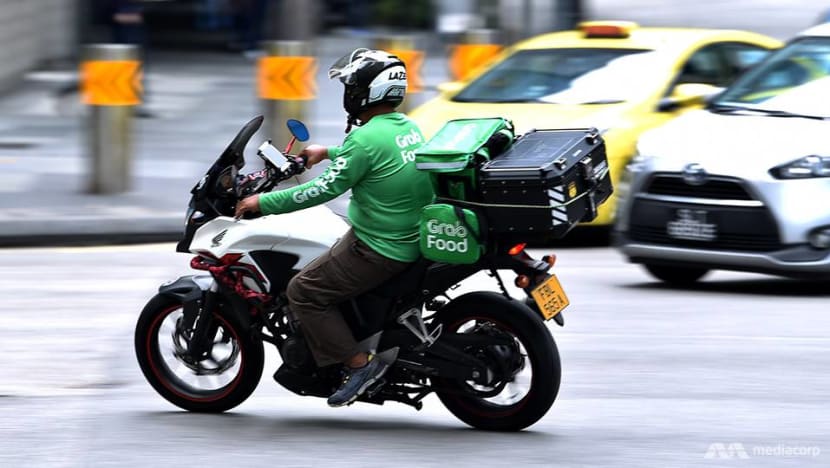Commentary: Wheels of change turning on relationship between delivery workers and platforms
Developments in the US, UK and China regarding gig work could inform Singapore’s approach towards delivery giants, says Li Jianggan.

File photo of a Grab Food delivery driver (Photo: Jeremy Long)
SINGAPORE: A reckoning is coming for delivery platforms that could shift the labour-enterprise balance.
While tech companies disrupted sleepy taxi and delivery industries to deliver nimbler, more competitive services benefitting consumers over the years, regulators are now catching up to push these firms towards greater emphasis on worker rights.
Singapore is the latest to join the chorus. Prime Minister Lee Hsien Loong mentioned in his National Day Rally speech, a specific concern for delivery workers working with online platforms.
He highlighted that they were “for all intents and purposes just like employees”, yet lack basic job protections like workplace injury compensation, union representation and employer Central Provident Fund (CPF) contributions.
GLOBAL WHEELS TURNING
Singapore’s move comes on the back of a global trend to strengthen safeguards for gig workers this year.
In February, the UK supreme court dismissed Uber’s appeal against a ruling classifying drivers as workers entitled to employment privileges, effectively setting a precedent for how millions of gig economy workers should be treated in the country.
In May, Spain enacted a new labour law requiring some delivery workers to be recognised as salaried staff.
In July, Chinese regulators published guidelines requiring platforms to provide a minimum income, insurance and relax delivery timelines for workers.
And in August, a Californian judge overturned Proposition 22 – which had allowed delivery riders and ride-hailing drivers to be treated as independent contractors instead of employees – on the basis it was unconstitutional and undermines the legislature's ability to pass future laws protecting workers.
WHY THE REVIEW NOW
When COVID-19 hit, businesses and workers could do little but focus on surviving the pandemic. With lockdowns, the retail, transport and service sectors took a hit.
Yet while Singapore, like many other countries, braced itself for closures and unemployment, tech platforms threw many restaurant owners, retailers and workers a critical lifebuoy.
The surge in food deliveries alone saw gross merchandise value in Southeast Asia grow by 183 per cent in 2020 as many countries went into mandatory lockdowns.
We know the 3.5 per cent unemployment figure, a 16-year high, could have been much higher.
But the attendant challenges may be coming home to roost. Own-account workers make up 190,900 or 8.1 per cent of employed residents in June 2020 according to the MOM Labour Force 2020 Report. This figure is possibly higher today than during the circuit breaker.
That would certainly be in line with global trends. In China, government figures suggested that about 200 million people were “flexible workers” in 2020, with delivery riders 7 million-strong. (Meituan counted 9.5 million delivery riders globally and Lalamove 4 million.)
The debate over the status of gig workers is not new but the meteoric rise of gig work had not given policymakers much time to approach its impact and risks for society and employment comprehensively.
FINE BALANCE
Gig workers surveyed in the MOM Labour Force 2020 Report stated lack of sufficient work (33 per cent), uncertainty of finding sufficient work (26 per cent), healthcare concerns (17 per cent) and retirement worries (14 per cent) as their biggest challenges.
Yet more are doing this line of work involuntarily after a job loss.
This is why many who take up deliveries as a main source of permanent income welcomed PM Lee’s comments and hope to see change in the industry.
Yet there is another segment who appreciate the freedom and flexible hours to tend to other family and personal priorities.
Conversations I have had with this group suggest they may only work for just two to three hours a day to supplement their income.
Governments across the world, used to defining employment status as full-time, formal and permanent, are rightly concerned about the implications of the rise of such temporary, irregular work.
But there is a fine balance to strike among the multiple stakeholders of a platform: Merchants want the lowest commission rates, consumers want goods delivered to them at an affordable price, people who choose to be delivery riders want sufficient work and flexibility, while platforms run thin margins but keep the business model viable through volume.
A cautionary tale is Deliveroo’s subsequent pull-out from Spain after the Government promised a law to give gig workers more rights. This resulted in loss of incomes and job opportunities.
EMPOWERING GIG WORK, GIVING WORKERS CHOICE
This is why China’s new guidelines in dealing with the rise of gig workers could be instructive. Eight ministries have come together to categorise gig workers into three main buckets:
- Full-time staff fitting traditional employment practices with full social security, healthcare and other employment benefits.
- Workers who may be treated like contractors completing projects - the current situation for gig workers in China.
- Those who leverage platforms as marketplaces for their businesses with more bargaining power (including sellers hawking goods on e-commerce apps or designers marketing their services on platforms including Zhubajie, China’s Upwork equivalent).
The second category remains vague for now with no mandatory rules except that companies should “encourage and guide workers to participate in relevant social security schemes according to their own circumstances”.
Worker rights are expected to be outlined in secondary legislation after extensive consultation with platforms later this year.
The Chinese government’s approach with the third group of workers who have more bargaining power is to enhance transparency so they understand their commercial agreements and have their rights, obligations and contractual arrangements codified.
This approach of providing a menu of options allowing workers to choose how much flexibility versus job security they may have also gives companies options to tweak the model without the blunt tool of restrictions mandating delivery workers be treated wholesale as full-time salaried staff.
MORE CAN BE DONE
As Singapore observes global developments to inform its own approach, three big issues loom large.
First, whether CPF contributions should be set aside for delivery workers reliant on platforms for a regular and primary source of income. These employer and employee CPF contributions are already mandatory for part-time, casual and temporary employees in Singapore.
After reports of prank orders, should the cash-on-delivery option be dropped? And does it sometimes seem like finding a food delivery rider takes forever? Guests dive into the belly of the beast of the food delivery world on Heart of the Matter:
Perhaps the trick is in drawing a line to define grounds for exclusion, for those engaged in this line of work on a temporary basis, put in fewer hours of work and could be paid per delivery.
This is a discussion that riders, platform providers and the Government need to reach a consensus on.
Second is how platforms can leverage their data and scale to work with partners to offer protection and benefits to gig workers.
For example, platforms have delivery activity data that insurance partners can use to create innovative and suitably priced pay-as-you go medical leave and personal accidental insurance which platforms can co-pay, without additional costs to merchants or customers.
These practices, already in place at Grab for ride-hailing drivers and UberEats in most of the US, should become an industry-wide practice.
Third, how platforms should be encouraged to work with the Government as nodes of training and upskilling so transient gig workers acquire skills to move into a permanent role.
Foodpanda has joined forces with Singapore Temasek Polytechnic and e-learning platform Gnowbe to offer free and discounted certification courses, while Grab is collaborating with Microsoft so riders with digital skills can capture IT roles and traineeship opportunities.
Linking these programmes up to job-matching services under Workforce Singapore and the Employment and Employability Institute can lower barriers to entry to full-time employment.
MOVING FORWARD
While big economies like California and strong governments like China can take tough regulatory action against their own companies, the story is different for a small country like Singapore – the proverbial sampan in the ocean that is a price-taker for tech platforms and foreign firms.
Singapore too should be careful not to pit labour against business, looking at how the polarised debate on organising delivery workers have divided societies.
It should also bear in mind that while stay-home 2020 and 2021 have been exceptional years where platform companies boomed, their top-line growth will slow if Singapore opens up, embrace endemic living and consumers start heading out.

As Singapore looks at how to marry the gig economy benefits with the desire for greater security, any long-term solutions the Government comes up with must be sustainable for the platform ecosystem and managed in stages so stakeholders can find their balance.
Ultimately, Singapore has always been able to tackle sensitive labour issues through forging a tripartite consensus, with Senior Minister of State for Manpower Koh Poh Koon’s announcement of an advisory committee to do just that last week a reassuring sign.
It’s worth remembering this is an issue not just about gig workers and platforms, but how we see the future of employment itself.
Li Jianggan is founder and CEO of Momentum Works, a Singapore-based venture outfit.




















